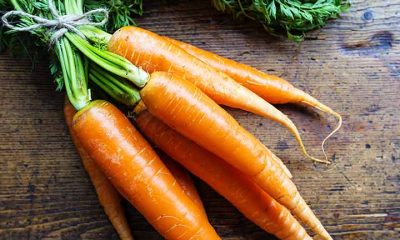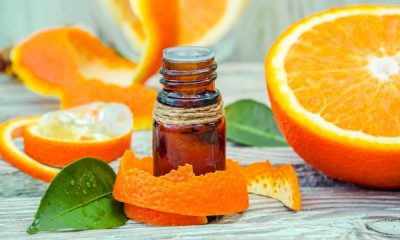Health
Health benefits of walnuts

Discover the Shocking health benefits of walnuts.
The walnut, from the Latin nux, nucis, is the fruit of the walnut tree and is characterized by its rounded shape and its rough and rigid shell. Its fruit inside is the edible part and below we will tell you its properties, health benefits, typologies, therapeutic uses of walnuts.
This food that we all know as one of the nuts, is original from Asia and its cultivation later spread to Europe and America. At present, walnuts have a world production of approximately 1.2 tons and the first producer is China.
Nutritional properties
They are considered a Superfood because they have excellent beneficial properties for health and among many of their nutritional properties are:
Vitamin E: the high content of walnut in vitamin E gives it a high antioxidant power and helps prevent the aging of our body
Potassium: the body needs this mineral to make protein, build muscle, and control the electrical activity of the heart
Polyunsaturated fatty acids: for them walnuts are so valuable for taking care of the heart and are considered the most suitable natural “medicine” to reduce coronary risks. Among these polyunsaturated fatty acids, their contribution in omega-3 stands out
Magnesium: together with potassium, the high magnesium content of walnuts (185 mg / 100 g) means that by consuming a small amount of them a day you already have the amount of magnesium recommended by experts.
Fiber: this nutrient helps reduce blood sugar levels and eliminate all waste from the body, so its consumption is essential in a healthy daily diet.
Vitamins of group B (B1, B2, B3, B6 and B9): favor the proper functioning of the nervous system, mental capacity (memory), even help to combat mild depression and the formation of kidney stones.
Phosphorus: essential for the proper formation of bones and teeth and, like the B vitamins, it favors memory.
Iron: known to all, iron prevents the appearance of anemia, strengthens the body’s immune system and improves moments of tiredness or fatigue.
Zinc: this property of walnuts will maintain good bone formation and stimulate the nervous and immune systems.
Health benefits of Walnuts
Like most nuts, the health benefits of walnuts are numerous and can surprise you with aspects that you didn’t even know about. We tell you which are the main ones and what you can improve your health by eating a small portion (about 30 grams is enough) of walnuts daily.
1. Reduce cholesterol levels
Reducing cholesterol is one of the great benefits of this organic product due to its high content of Omega 3 fatty acids of vegetable origin
2. Cardiovascular health
The fats and minerals in walnuts help prevent cardiovascular disease and have a healthy heart. Specifically, eating about 30 grams of nuts a day, of which at least half must be walnuts, reduces the risk of cardiovascular accidents by 30% according to a study published in The New England Journal of Medicine.
3. Good for the brain
Take care of your brain is the slogan that we could associate with the walnut, its nutritional properties improve the neuronal capacity of the body. Its neuroprotective compounds help improve cognitive and motor function of aging.
4. Energy booster
Nuts are composed of healthy fats or fats of vegetable origin , specifically the walnut contains 21 grams per 100 of product, which will provide you with extra energy in your day to day.
For athletes they can be a great contribution of energy value, it is good to take them after intense physical effort (long-term sports) because of their high content in Omega 3 and their low water content, because they help to recover after exercise.
5. Fight constipation
They also regulate intestinal transit thanks to their high fiber content and combat the dreaded constipation. You will satisfy your appetite and arrive with less anxiety to the main meals of the day
6. Improve sleep
Its content in tryptophan and vitamin B6 favor muscle relaxation, sleep, even fight insomnia. Its contribution of polyunsaturated fatty acids (such as linoleic acid) delay the appearance of sleep disorders.
7. Immune system booster
They boost the immune system , so walnuts help your body protect itself from external agents and feel better and healthier every day.
Did you know that the month of April is the month of the Nut?
Types of walnuts
We have already commented that eating nuts is beneficial for health, and more if they are organically grown.
In addition, we are going to explain what types of nuts are on the market and how each one is different.
California walnuts are one of the best known types, but this does not make them the best quality compared to some types of European walnuts.
It is large in size and regular in shape. Spain is the largest consumer of walnuts in the world and almost 80% of this consumption is of the California variety.
Pecans: this type of nut is from America, it looks like the Californian but more elongated and smooth.
It has a special aroma and a very pleasant taste, which is why it is used in the preparation of many recipes, sauces and desserts.
Castilla walnuts, due to their name, comes from European walnut or Spanish walnut and the ideal season to consume them is the autumn season.
These nuts are more antioxidant than the rest of the types and we recommend that you eat them unroasted, naturally.
Cedar nuts. It is the most exotic type of all, it comes from Russia and they are good for your health because they reduce the amount of LDL cholesterol. They are composed of 70% of the essential amino acids that the body needs.
Therapeutic uses of walnuts
Walnuts have, among all their beneficial characteristics for the body, a series of therapeutic uses that can help to partially counteract the symptoms of some ailments or diseases as we tell you now.
Organic nuts are rich in vegetable fats, fibers and magnesium and have a low glycemic index, therefore, they are beneficial to reduce the risks of type 2 diabetes .
Eating a healthy diet and adding the consumption of organic or organic nuts daily, of course under the supervision of your doctor, can help delay or reduce the onset of diabetes.
Did you know that including 9 nuts a day in your diet can have calming effects on your body?
Yes, the Omega 3 fatty acids contained in the walnut have beneficial effects on blood pressure.
Therefore, its moderate daily consumption calms states of stress , anxiety and nervousness, since they reduce blood pressure.
They are the best natural “treatment” for the heart and if they are organic you are also taking a 100% healthy product.
Include walnuts in your usual consumption as they reduce the appearance of cardiovascular diseases such as: arteriosclerosis, hypertension, myocardial infarction or angina pectoris.
They are indicated for states of lack of energy, forgetfulness or even Alzheimer’s symptoms, since they help to slow down the aging of global cognitive capacity and memory loss because they are a source of fiber and antioxidants.
The consumption of nuts during pregnancy is very beneficial because its nutrients: fiber, calcium, sodium, phosphorus, folic acid,… help reduce the risk of spina bifida in the fetus.
In addition, its calming and relaxing effect help the pregnant woman to improve intestinal transit and lower blood pressure.
Walnuts in the kitchen
We are not going to forget the gastronomic use of walnuts in our diet. Nuts should be part of the fundamental foods for their contribution of nutritional and beneficial properties for the body.
For this reason, there are many and different ways to include the walnut in our daily kitchen, we are going to review them.
Generally its consumption is done raw, alone or accompanied by other products such as yogurt, cheese or other nuts. But nuts are ideal to include in thousands of recipes, sauces or desserts.
There are other culinary uses for walnut, such as walnut oil. It is not an oil to use, but is consumed raw, it would not serve you to fry or cook other foods. But it can be used for dressings or as an ingredient in recipes or more elaborate dishes.
Appetizers are usually the perfect complement to arrive without anxiety at mealtime. And walnuts, due to their high content of healthy nutrients for the body, become the ideal snack to take without neglecting your body or your health.
We hope the article on the Shocking health benefits of walnuts has been of help.
Health
14 Benefits of Oolong tea and side effects Table of Contents
Health
Contraindications of drinking green tea

Discover the contraindications of drinking green tea.
Drinking green tea in excess can cause some harmful side effects for the body, which are necessary to know
Green tea is one of the most popular in the world. In addition to having a characteristic flavor, its different properties make it a highly beneficial drink for health, mainly due to its antioxidant power. However, its consumption also includes a series of contraindications
Among the benefits of green tea highlights its ability to improve memory, helps lose body fat, increases physical performance, is stimulating, can prevent different types of cancer, and even reduce the risk of cardiovascular diseases.
Among all the types of green tea that exist, matcha stands out, a tea of oriental origin with important properties for health and that stands out for its powder composition. In recent years it has become the travel companion of celebrities, athletes, and famous people.
Contraindications of drinking green tea
Many people have incorporated green tea into their day-to-day. The truth is that it is a great choice since it can provide energy to face the workday, accelerate the metabolism, and can even help improve mood.
However, like any food, the consumption of green tea carries a series of contraindications that it is necessary to know.
Thus, from ‘Todo Disca’ we are going to expose some of the negative effects that the ingestion of this type of infusions can produce.
In this sense, researchers from the National Institute of Health of the United States affirm that the consumption of green tea mixed with different medications, such as contraceptive pills, antibiotics, stimulants, or alcohol can be harmful to health.
And these are some of the side effects that excess green tea consumption can generate for the body:
1. Irritability: Some people feel some discomfort at the time of their intake. That is to say, it produces an effect contrary to the one they seek at first.
2. Insomnia: Green tea can cause sleep problems for many people. And is that it is a stimulating drink that contains some doses of caffeine, although in a lower proportion than traditional coffee.
3. Dizziness and nausea: This infusion can be heavy for delicate stomachs and generate some type of gastrointestinal discomfort. Therefore, it is not advisable to take on an empty stomach.
4. Palpitations: Due to its stimulating characteristics, it can sometimes cause palpitations. Along these lines, experts recommend reading the indications and ingredients of all types of tea.
5. Disadvantages during pregnancy: Green tea is rich in tannins, so it can reduce the absorption of folic acid and iron. Due to this, this drink is not recommended for pregnant or lactating women.
Generally, green tea is an infusion with excellent health properties. In this way, moderate consumption usually brings different benefits to the body.
However, it is advisable to take these contraindications into account, and if you feel any side effects, see a medical specialist.
Through the following link, you will be able to know the contraindications to drink matcha tea, a variety of oriental origin widely established in Europe and whose consumption has become popular in recent years
Health
15 Benefits of pumpkin seeds and side effects

Table of Contents
- 1. Pumpkin seeds to boost the immune system
- 2. They are high in magnesium
- 3. Pumpkin seeds are low in calories
- 4. Pumpkin seeds are rich in iron
- 5. Relieve symptoms of irritable bladder
- 6. Pumpkin seeds are high in fiber
- 7. Benefits of pumpkin seeds for cholesterol
- 8. Pumpkin seeds are a natural anti-inflammatory
- 9. Pumpkin seed oil to counter the effects of menopause
- 10. Pumpkin seeds help healthy skin, hair and nails
- 11. Pumpkin seeds help eliminate kidney stones (kidney stone)
- 12. Pumpkin seeds are rich in vegetable protein
- 13. Pumpkin seeds are a great substitute for peanuts
- 14. benefits of pumpkin seeds on your hormonal health
- 15. Pumpkin seeds are a good source of potassium
- Discover the 15 powerful health benefits and virtues of pumpkin seeds and side effects.
They are packed with nutrients and vitamins, are high in protein, fiber and are low in calories!
-
1. Pumpkin seeds to boost the immune system
Pumpkin seed helps boost the immune system , especially because it is rich in zinc.
Remember that zinc allows the proper functioning of the immune system by ensuring optimal activity of T lymphocytes. Zinc could also help the body to better protect itself against colds, flu, conjunctivitis and other infections.
2. They are high in magnesium
Anxiety , migraines, muscle cramps and PMS can result from magnesium deficiency. A 28g serving of pumpkin seeds provides almost 20% of the recommended daily allowance.
The magnesium intervenes in the transformation of food into energy, the transmission of nerve impulses, muscle relaxation and the formation of bones and teeth.
- Acting with calcium and potassium, it regulates the heart rate and participates in the production of insulin.
Several studies have also demonstrated the virtues of magnesium in the prevention of cardiovascular disease.
3. Pumpkin seeds are low in calories
Pumpkin seeds are lower in calories than many nuts. A 28g serving of pumpkin seeds (2 tablespoons) without their raw shell has 126 calories, which is almost 40 calories less than almonds and 60 calories less than walnuts for a single serving.
4. Pumpkin seeds are rich in iron
Pumpkin seeds are a great source of iron. A 28g serving of pumpkin seeds provides almost 5% of the recommended daily allowance.
Remember that iron is essential for health and is involved in a multitude of functions in the human body, in addition to transporting oxygen through the body.
However, iron from plant sources is not as well absorbed as iron from animal sources. In this sense, it is recommended that vegetarians consume twice as much iron in order to ensure that they do not suffer from deficiencies that may in particular cause fatigue and weakness.
5. Relieve symptoms of irritable bladder
While more scientific studies are to be conducted on the subject to understand all of its mechanisms, pumpkin seeds are believed to help relieve symptoms of irritable bladder and urination disorders associated with benign prostatic hyperplasia (BPH). .
6. Pumpkin seeds are high in fiber
Pumpkin seeds also provide a healthy dose of fiber . A 28g serving of pumpkin seeds provides 5g of fiber, or 20% of the recommended daily intake.
In addition to calming hunger, fiber promotes healthy digestion and helps regulate bowel function.
7. Benefits of pumpkin seeds for cholesterol
The phytosterols in pumpkin seeds help lower ” bad” cholesterol levels . Phytosterol is the plant equivalent of cholesterol. However, rather than blocking the arteries, phytosterol rather helps to clean them, recalls WebMD.
8. Pumpkin seeds are a natural anti-inflammatory
Source of antioxidants, pumpkin seeds have an anti-inflammatory effect and thus help defend the body against damage caused by excess free radicals .
If free radicals oxidize DNA (the body’s genetic code) in a cell’s nucleus, a cell mutation can occur, which can start cancer. Oxidation of cholesterol in the blood can lead to the formation of fatty deposits in the arteries, which can lead to heart disease or stroke.
Excess free radicals are also involved in cataracts, immune deficiencies, arthritis and premature cell aging; their role in these diseases is the subject of intensive research.
9. Pumpkin seed oil to counter the effects of menopause
Researchers have studied the impact of pumpkin seed oil in better combating symptoms of menopause , including hot flashes and headaches.
While further studies need to be done, pumpkin seed oil has been shown to be effective in alleviating these symptoms in the subjects of this research.
10. Pumpkin seeds help healthy skin, hair and nails
The pumpkin seeds contain essential fatty acids, zinc, vitamin A and vitamin E . These nutrients help maintain glowing skin , strong, healthy hair and nails .
While more research is needed to confirm these benefits, a study with 76 participants also looked at the benefits of pumpkin seed oil in helping hair regrowth in men with alopecia.
In subjects who consumed 400mg of pumpkin seed oil for 24 weeks, regrowth was 40% greater than participants who took a placebo.
11. Pumpkin seeds help eliminate kidney stones (kidney stone)
Pumpkin seeds are also said to prevent kidney stones from forming . To better counter kidney stones, it is also recommended to drink plenty of water, limit sodium intake, and consume no more than 2g of vitamin C on a daily basis.
The kidneys are designed to remove particles of salts and minerals that end up in the ureter, a long, narrow duct leading to the bladder; they will then be expelled in the urine.
Problems arise when a chemical imbalance or other deficient process promotes the agglutination of particles, which turn into crystals and then into a kidney stone.
12. Pumpkin seeds are rich in vegetable protein
This food is also a good source of vegetable protein . A 28g serving of pumpkin seeds provides 5g of protein, or 10% of the recommended daily allowance.
The proteins include the ability to develop and maintain the muscles, in addition to help regulate and control hunger cravings.
Vegetarians and vegans, however, should make sure that their diet meets all their amino acid needs by combining different sources of plant protein (legumes and grain products, for example).
13. Pumpkin seeds are a great substitute for peanuts
In 10 years, cases of peanut allergy have doubled, forcing several schools to ban this food. Pumpkin seed butter is a good alternative.
At lunch or as a side dish for a snack, it will provide children with some of the essential fatty acids and proteins they need.
14. benefits of pumpkin seeds on your hormonal health
Pumpkin seeds may help women with hormonal imbalance due to the phytoestrogens they contain. However, further scientific studies need to be carried out to this effect.
The Extenso Nutrition Reference Center reminds us that phytoestrogens are compounds of plant origin which, when consumed in sufficient quantities, can act on your body in a manner similar to estrogen.
In addition to regulating the menstrual cycle, I pregnancy, and breastfeeding, estrogen helps prevent demineralization of your bones and keeps your blood vessels healthy.
15. Pumpkin seeds are a good source of potassium
Finally, pumpkin seeds provide a good source of potassium. A 28g serving provides 260mg of potassium , or nearly 7% of the recommended daily allowance.
Potassium is present in the form of a solution in the body and almost all of it is concentrated inside cells.
Like chlorine and sodium, it is an electrolyte, a substance that charges positively or negatively when dissolved.
The body needs a balance between potassium, chlorine and sodium to perform a multitude of essential functions.
We hope the article on the 15 powerful health benefits of pumpkin seeds has been of help.
-

 Food1 year ago
Food1 year ago10 + Benefits of carrot juice and side effects
-

 Benefits4 months ago
Benefits4 months agoThe Benefits of Joining Gym Lumolog – Improve Your Fitness & Health
-

 Health1 year ago
Health1 year ago50 Super Healthy (And Very Often Cheap) Foods
-

 Health1 year ago
Health1 year ago5 Shocking health benefits of kinkeliba and side effects
-

 Food1 year ago
Food1 year ago8 shocking benefits of leek juice and side effects
-

 Health1 year ago
Health1 year agoBenefits of guava leaves Sensually
-

 Weight Loss1 year ago
Weight Loss1 year agoChaz Bono weight loss secret
-

 Health1 year ago
Health1 year ago15 Benefits of lipton tea and side effects













